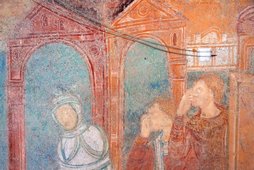St. Georg on the Monastic Island of Reichenau
In 2000, the Island of Reichenau was recognized as a UNESCO World Heritage Site. St. Georg thus received its rightful place in the circle of the most important cultural monuments in the world. The early medieval building, with its unique monumental murals from the second half of the 10th century, is considered the most outstanding monument of an entire epoch.
Overpainted, forgotten and rediscovered: the restoration history of the murals
In the 14th century, the cycle of the murals in St. George underwent a complete overpainting. The original image composition was complied with, albeit for some detail and formal changes. A revision of the murals with redesigns, can be found during the 17th and 18th century. With an expansion of the clerestory windows in 1787/88 the church received a whitewash. The concealed murals were rediscovered in 1879 and subsequently uncovered by 1881.
Four decades of research
An extensive investigation and restoration of the murals took place as part of a pilot project from 1982 - 1990 led by the Landesdenkmalpflege Baden-Württemberg. (State Office for the Preservation of Historic Monuments.) The restoration concept was preceded by pioneering investigations in its methodology. The documentation of these results set standards for the preservation of monuments across Baden-Württemberg.
A research project funded by the German Federal Environmental Foundation (DBU)
A research project to stabilize the climate and preserve the murals endangered by environmental influences was funded by the German Federal Environmental Foundation (DBU) during 2015-2017 and made it possible to continue the research of through the 1980s. An interdisciplinary team in the fied of preservation, conservation, natural and engineering sciences, examined the potential hazards facing the future of the murals as a result of climatic fluctuation. Measurements of the factors causing damage; such as, salts, microbial infestation and dust particles provided new insights into the harmful processes.
Analytical investigation of the pigments in the murals
Scientific investigations on the murals in St. Georg were carried out to identify the used pigments and their apparent transformation over the centuries. For the protection and preservation of the extremely valuable mural, mobile non-destructive onsite analyzes by means of X-ray fluorescence and Raman spectroscopy were used for the present. Solely for the clarifi cation of complex issues the smallest samples were taken for analysis to determine both the mineral and exact chemical composition of the material – under laboratory conditions. In an art historical context, the interpretation of the analysis in the crypt led to a fresh evaluation of the original color scheme.
Measuring and control concept for the preventive conservation of murals
Since the 1980s, the climate values in St. Georg were recorded by the State Offi ce for the Preservation of Historic Monuments. From 2011, a new climate monitoring system was installed to record and evaluate the climatic conditions that occur during the course of the year, in relation to the intensity of visitor numbers and also with regard to the pervading sunshine’s path.
Air monitoring in St. Georg: Dust particles and their sources
In buildings that are subject to tourism and use, the question arises as to whether potential pollutants, which may have an adverse effect on the mural, are registered. In addition to indoor climate monitoring in the church and crypt, an additional monitoring of gaseous compounds and particulate matter (fi ne dust and deposited dust) was carried out. The aim was to evaluate the anthropogenic pollutant input and the resulting damage potential.
Molds and other microorganisms
Mold fungi as well as other microorganisms repeatedly occurr in St. Georg. When they first appeared can not be determined. With the increased use of the church, corresponding to an increase in tourism, the climate within has dramatically changed, resulting in mold and other microorganisms growing faster and more widespread. Since the introduction of visitor guidlines and a climate improvement stratergy, as part of the DBU research project, the activity of mold fungi and other microorganisms has declined significantly.
Edifice damaging salts are amongst the worst enemies of buildings
In the run-up to the implementation of measures to improve the room air quality by means of controlled ventilation and temperature in the crypt, a careful analysis of the salts in the masonry and the moisture content had to be made. Only in this way it can be ensured that the room climate adjustments, carried out to prevent further mold growth in the crypt, do not result in secondary damage in the form of increased crystallization of the salts in the brickwork.
Fachgebietsleitung Restaurierung Bau- und Kunstdenkmalpflege
Dienstsitz Esslingen
73728 Esslingen am Neckar
83.3
Conference transcript
Projectposter
















